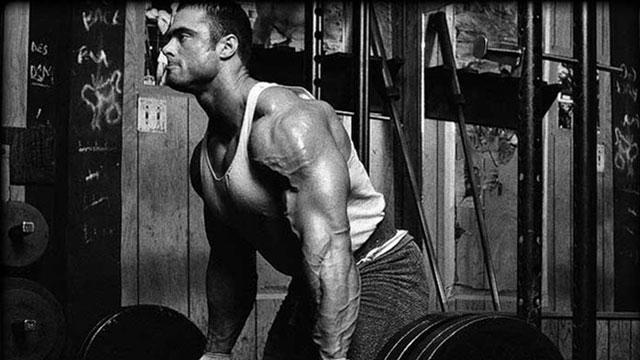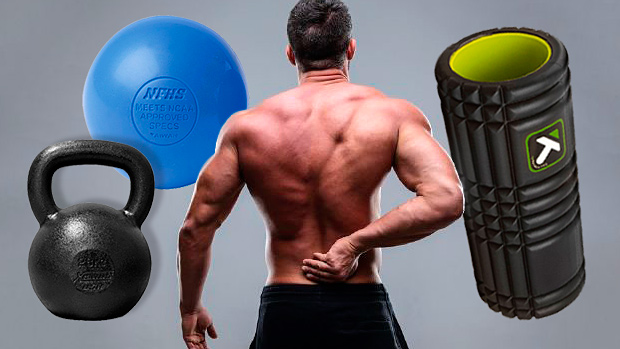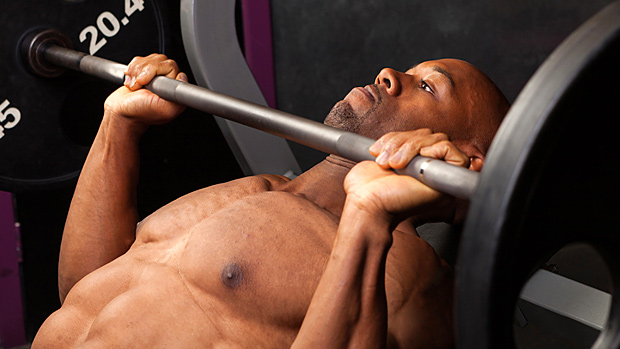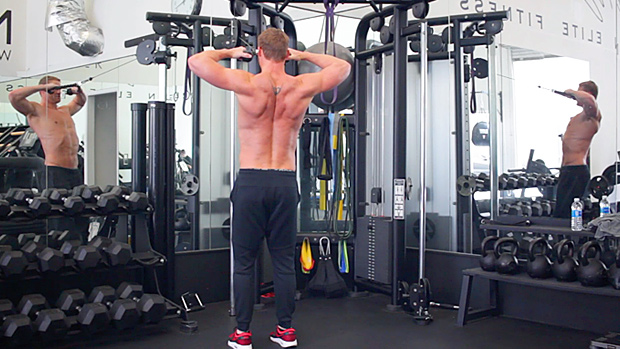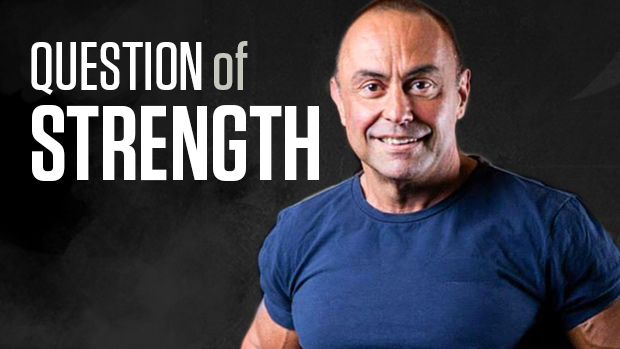Here's what you need to know...
- You can't train the deadlift heavy all the time and make progress. Speed deadlifts with a moderate weight are needed on occasion.
- Do not round the lower back. This is caused by either a weak lower back or a bad start position.
- To deadlift more weight, master starting strength, not reversal strength. To fix this, focus on training single reps, not multiple.
- The top deadlifting mistake is starting with the hips too low and "squatting" the weight up.
- If you want to get stronger, find a real gym and train around people who are stronger than you.
Whenever I go on the road, I have to find a place to train. I usually look for something with a name like "Iron Pit." If that's not available I settle for a big commercial gym.
On one occasion I pulled into the parking lot and knew it was going to be a long day. From the outside the place looked too nice. Those of you who train in a hardcore gym know exactly what I mean.
During my third set of deadlifts I turned and saw some 20-something kid who was wearing a polo shirt and looked to be about 165 pounds dripping wet. I motioned him off like an annoying mosquito and pulled my fourth set.
After my set I asked the kid if I could help him. He asked a question I'll never forget. "What are you doing?" he said.
I thought to myself, "What the hell does it look like I'm doing?!" Out loud, I replied very kindly that I was doing deadlifts. He then informed me that they didn't allow deadlifts in this gym. Now I was getting a little pissed.
He told me that the weights hitting the floor are too loud and it bothers the other members. So I told him the sound of the treadmills and Stairmaster motors are too loud and that bothers me. Why doesn't he go over and tell the other patrons to get off the machines?
At this point I must've pissed him off because he said under his breath that I wasn't even doing the deadlifts right. I asked him what he saw wrong in my technique. (You never know, he could've seen something I was missing.) He told me that I needed to sit lower to the ground and pick the weight up with good form and not use my back. He also told me my shins had to stay close to the bar and I should be using a wider stance.
While not being a dick, I asked him where he'd learned this information. Then I saw it. I couldn't believe I'd missed it the first time, but there it was right in my face: a gold name badge with his name and "head trainer" right underneath it.
At this point I asked him if I could finish my last set at which point I'd love to sit down and discuss his training concepts with him. He was cool with that so I pulled my last and by far best set. Maybe it was the added geek aggression that made the difference.

As I tore the bar down I started up a friendly dialog with Mr. Head Trainer. I let him know I was in town to work with a few ball players on their strength-training programs. He told me he'd been in the personal training field for three years, has been to several conferences, and this was where he learned how to lift.
Out of curiosity I asked him how much he could deadlift. He told me he could pull 315 for five reps. I spent the next hour going over with him what I felt were the ten biggest mistakes in the deadlift.
The first thing I told him was the old deadlift motto: The meet doesn't end until the bar hits the floor. To a powerlifter, the deadlift can be the end-all or the end-of-it-all when it comes to closing out a total or placing in the competition. In short, we have to know how to deadlift the most weight in the safest manner or we'll have a very short career.
I also told him that most people never read a whole lot about the deadlift because of one reason: it's very hard and demanding to train and perform the deadlift.
To be frank, most in the strength training/fitness/bodybuilding field would rather come in the gym and train their back with various pulley machines, talk to the girls, and go home. They like to live on the light, easy side of the game while avoiding the dark side.
Well, get ready to enter the dark side as I share with you what I told my new personal-trainer buddy.
1. Training the deadlift heavy all the time
Very few people can train the deadlift week after week and still make progress. I feel the only ones who can get away with this are the ones who're built to deadlift. If you're built to pull, then the stress on your system is going to be less than those who aren't built to deadlift.
The deadlift is a very demanding movement and it takes a lot to recover from. This is compounded if you're also squatting every week. The squat and deadlift train many of the same muscles and this is another reason why you don't need to train the deadlift heavy all the time.
Years ago the only deadlifts I did off the floor were in meets. The rest of the time was spent training the lower back, glutes, and hamstrings. While my deadlift increased 40 pounds over the first few years, I did run into some problems with this approach.
The major problem I had was when I'd go to a meet I didn't know where to place my feet and if I got stuck I didn't know how to adjust. Since I'm not built to deadlift, these things aren't natural to me. I had to find a way to put some pulling back in the program without taxing the system.
What we came up with was a session of speed deadlifts with a moderate weight pulled for five or six singles. This way the weight was heavy enough to teach good form and not too heavy to tax the system. This worked out to 45 to 50% of max to be trained after the dynamic or speed squat workout. These don't need to be done every week but should be used as the meet or test day get closer.
I still suggest letting the box squat train the deadlift muscles with dynamic squat training of eight sets of two reps in a wave-like sequence. Let the max-effort day be for training the heavy deadlift. Try to pull off pins, off mats, or with bands one out of every four to six max effort days. Let the other day be some type of medium or close-stance good morning or low-box squat.
2. Pulling the shoulder blades together
This is a mistake I made for years. Stand in a deadlift stance and pull your shoulder blades together. Take a look at where your fingertips are. Now if you let your shoulders relax and even round forward a little you'll see your fingertips are much lower. This is why we teach a rounding of the upper back. First, the bar has to travel a shorter distance. Second, there's less stress on the shoulder region. It'll also help to keep your shoulder blades behind the bar. You'll read more on this later.
3. Rounding the lower back

This is another mistake I see all the time and most lifters know better. It happens because of a weak lower back or a bad start position. While keeping your shoulders rounded you must keep your lower back arched. This will keep the shin straight and the shoulders behind the bar and keep your body in the proper position to pull big while keeping the back under minimal stress.
If you pull with a rounded back, the bar is going to drift forward away from the legs, thus putting you back into a very difficult position from which to recover. When the bar drifts forward, the weight of it will begin to work against your leverages and cause you to have a sticking point just below the knees or mid-shin level.
When you pull you can either arch your back in the beginning standing position before you crouch down to pull or once you grab the bar. Either way it's important to keep the lower back arched and tight.
There are many ways to strengthen the lower back for this. Good mornings, reverse hypers, and arched back good mornings are a few. You can also use a band around your traps and feet for simulated good mornings. With this technique you only use the bands and train for higher reps (in the 20 to 30 rep range) for local muscular endurance.
4. Not having enough air in your belly
As with most exercise you must learn how to breathe. Stand in front of a mirror and take a deep breath. Do your shoulders rise? If so, then you need to learn how to breathe.
Learn to pull your air into your diaphragm. In other words, use your belly! Pull as much air into your belly as possible, then when you think you have all you can get, pull more. The deadlift isn't started by driving your feet into the floor; it's started by driving your belly into your belt and hips flexors.
One note on holding air while you pull. You do need to try and hold your air as long as possible, but this can only last for a few seconds while under strain because you'll pass out. So for a long pull, you're going to have to breathe or you'll hit the floor and people will stare. While there are several people out there who may think this is a cool thing, I disagree. It's much cooler to make the lift!
So when you reach the point where you begin to really have to fight with the weight, let out small bursts of air. Don't let it all out at one time or you'll lose torso tightness and cause the bar to drop down. By letting out small bursts you can keep your tightness, continue to pull, and lock out the weight.
5. Not pulling the bar back
The deadlift is all about leverage and positioning. Visualize a teeter totter. What happens when the weight on one end is coming down? The other end goes up. So if your body is falling backward, what happens to the bar? It goes up! If your weight is falling forward the bar will want to stay down.
So if you weigh 250 pounds and you can get your bodyweight to work for you, it would be much like taking 250 pounds off the bar. For many natural deadlifters this is a very instinctive action. For others it has to be trained.
Proper positioning is important here. If you're standing too close to the bar it'll have to come over the knee before you can pull back, thus going forward before it goes backward. If your shoulders are in front of the bar at the start of the pull, then the bar will want to go forward, not backward. If your back isn't arched the bar will also want to drift forward.
For some lifters, not being able to pull back can be a muscular thing. If you're like myself, I tend to end up with the weight on the front of my feet instead of my heels. This is a function of my quads trying to overpower the glutes and hamstrings, or the glutes and hamstrings not being able to finish the weight and shifting to the quads to complete the lift.
What will happen many times is you'll begin shaking or miss the weight. To fix this problem you need to add in more glute ham raises, pull-throughs and reverse hypers.
6. Keeping the shins too close to the bar

I'm not too sure where this started but I have a pretty good idea. Many times the taller, thinner lifters are the best pullers and they do start with the bar very close to their shins. But if you look at them from the sides they still have their shoulders behind the bar when they pull. This is just not possible to achieve with a thicker lifter.
If a thicker lifter with a large amount of body mass – be it muscle or fat – were to line the bar up with his shins, you'd see he would have an impossible time getting the shoulders behind the bar. Remember you need to pull the bar back toward you, not out and away from you.
So what I believe happens is many lifters look to those who have great deadlifts to see how they pull, then try to do the same themselves. What they need to do is look to those who are built the same way they are and have great deadlifts and follow their lead.
7. Training with multiple reps
Next time you see someone doing multiple reps on the deadlift, take note of the form of each rep. You'll see the later reps look nothing like the first.
In competition you only have to pull once, so you need to learn how to develop what's known as starting strength for the deadlift. This is the strength needed to get the bar off the floor without an eccentric (negative) action before the start.
In other words, you don't lower the bar first and then lift the weight as you do with the squat and bench press. When you train with multiple reps you're beginning to develop reversal strength, which isn't needed with the deadlift.
These two reasons are enough to keep the deadlift training to singles. If you're using multiple reps with the deadlift, then stand up in between each rep and restart the lift. This way you'll be teaching the proper form and be developing the right kind of strength.
8. Not keeping your shoulders behind the bar
This is perhaps the most important thing next to hip position in the execution of the deadlift. Your shoulders must start and stay behind the barbell when you pull deadlifts! This will keep the barbell traveling in the right direction and keep your weight going backward. The deadlift isn't an Olympic lift and shouldn't be started like one.
I did a seminar with Dr. Mel Siff and we showed the difference between the two positions. For the Olympic lifts you want the shoulders in front of the bar; for the deadlift you want them behind the bar. Period. The amount of misinformation out there about this is incredible.
9. Looking down
Your body will always follow your head. If you're looking down then the bar is going to want to travel forward.
At the same time you don't want to look at the ceiling. Focus on an area that keeps your head in a straight up and back position with the eyes focusing on an upper area of the wall.
10. Starting with the hips too low

This is the king of all mistakes I see. Too many times lifters try to squat the weight up rather than pull the weight.
Think back to the number of times you've seen a big deadlift and thought to yourself how much more the lifter could've pulled if he didn't damn near stiff-leg it. I see it all the time. Someone will say, "Did you see his deadlift?" Then the other guy will comment, "Yeah, and he stiff-legged the thing." Am I telling you to stiff-leg all your deadlifts? No, not at all.
All I want you to do is look at your hip position at the start of the lift when you pull and watch how much your hips move up before the weight begins to break the floor. This is wasted movement and does nothing except wear you out before the pull. The closer you can keep your hips to the bar when you pull, the better the leverages are going to be.
Once again, next time you see a great deadlifter, stand off to the side and watch how close his or her hips stay to the bar throughout the pull. If you're putting your ass to the floor before you pull, your hips are about a mile from the bar. You're setting yourself up for disaster when the lever arm is this long. This is also the second reason why lifters can't get the bar off the floor. (The first reason is very simple: The bar is too heavy!)
You need to find the perfect spot where your hips are close to the bar, your shoulders are behind the bar, your lower back is arched, your upper back rounded, your belly full of air, and you can pull toward your body. Nobody ever said it was going to be easy, but then again, what is? (Definitely not training in a commercial health club...)
After I'd discussed my pulling concepts with my new trainer friend, he was a little set back. He'd never heard these things before and didn't really know what to believe.
After this I took him back out on the gym floor and started guiding him through a few deadlifts. A few corrections here and there and in no time at all he pulled 405. This wasn't an easy lift for him but he made it and with that his confidence grew.
Next, I let him in on the best training advice he'd ever hear. I told him the first thing he needed to do was spend more time under the bar and suggested he find a real gym and start training with those who were much stronger than him.
The best training secrets come from the small garage gyms with very strong lifters, not the spandex driven, neon-machine warehouses. This, I told my friend, would be his introduction to the dark side, and with hard work and proper training, he may one day even enter the Dead Zone!
When Biotest CEO Tim Patterson first asked me about trying Plazma™ I was extremely skeptical. But I took him at his word and gave it a shot, and was completely blown away by the results. In fact, I contribute much of my recent success to Biotest's Plazma.™ The stuff just flat out works. You get leaner almost daily while adding weight and strength. It's nuts.
If you don't believe me, look at John Meadows. He's added 10 pounds of stage weight in one season and the only thing he changed in his prep was adding Plazma™ during his workouts. For competitive bodybuilder at his level of development, gaining 10 pounds like that is ridiculous.
I feel like Plazma™ buys me considerable leeway. I can basically screw up my diet everywhere else and as long as I take in this protocol, I'll meet my body's needs and grow. That's a huge plus for me.
I have enough to think about, so the last thing I want is to be stressed about what I eat. It's nice knowing that as long as I have Plazma™ during my workout I can basically cruise through the rest of the day. So if anything, this workout protocol is a huge stress reliever.
Dave Tate

